Extraordinary generosity
An exciting new tool for AOPA’s mission
The question came without preface or preamble: “If I were to donate my Extra to AOPA, would the association have a purpose for it?”

Bruce Williams, a flight instructor, aviation writer, and former Microsoft manager who played major roles in the company’s highly successful Flight Simulator programs, wasn’t kidding.
Williams had used the Extra to provide unusual attitude and spin training, and the two-seat, 300-horsepower airplane migrated between his home in Seattle each summer, and Boulder City, Nevada, every winter. He’d flown it very little during the previous two years, however, due to the COVID-19 pandemic and now he was considering the future of N105MM, an unlimited aerobatic airplane with a unique pedigree.
His Extra had been gently flown (for an aerobat, anyway), was maintained to the highest standards, and almost never spent a night outdoors. If Williams decided to sell, N105MM could fetch a premium price. But Williams was sure his airplane still had lifesaving lessons to teach, and the AOPA Air Safety Institute could reach the largest number of general aviation pilots and help them avoid loss-of-control accidents, the single largest cause of fatal crashes. AOPA Air Safety Institute Senior Vice President Richard McSpadden enthusiastically backed the idea, and other association leaders saw roles for the specialized airplane in initiatives including AOPA’s high school education program and fundraising.
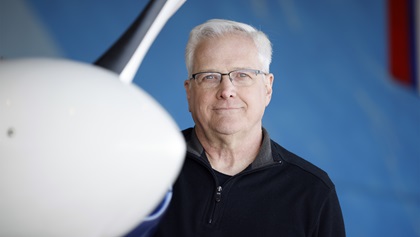 In short order, Williams made the donation official.
In short order, Williams made the donation official.
An AOPA contingent including Senior Vice President of Communications and Outreach Tom Haines, Senior Photographer Chris Rose, and me traveled to Boulder City Municipal Airport with Williams to meet N105MM and learn how to care for it. He took me for a short flight over the desert and showed me his preferred method for approaches and landings.
“Shoot for 85 knots on final and carry some power into ground effect,” he said. “Then go to idle power, work the stick aft for a three-point landing—and try not to overcontrol it.”
The next morning, I began the transcontinental ferry trip to AOPA’s home base in Frederick, Maryland. Like any pilot, I was eager to fly the sleek, powerful aerobat with a reputation for exquisite control harmony, reliability, and refinement. But Williams, a veteran of many marathon ferry flights throughout the Mountain West, warned that a long trip in winter would be arduous.
“The first thing you should know is that the airplane has no heater,” he said. “The second thing is that it’s drafty. No matter how many layers of clothing you put on, you’re going to wish you had more.”
‘Don’t baby it’
The weather on departure day was ideal. Cool and calm at the surface with a gray layer of high cirrus clouds to spare my eyes from the morning sun.
Doug Vayda, an Extra pilot with more than 4,000 flight hours in these demanding airplanes, provided some technical insights.
“Dress as if you were flying an open-cockpit biplane,” he said. “If you get a fouled mag on the ground, clear it in the air. The engine is happiest when you run it hard, so don’t baby it.
“Use up the fuel in the wings first and save the fuselage tank (about 10 usable gallons) for descent and landing,” he said. “And have a blast.”
Bundled up in long johns, wool socks, an insulated flight suit, double gloves, a jacket, a cloth helmet, and a neck gaiter, I moved awkwardly as I cinched my backpack into the vacant front-seat harness, then crammed flight gear, snacks, and water into the baggage area behind the headrest.
Latched and ratcheted into a seven-point harness, I started the engine, S-turned down the taxiways, ran up, then prepared to launch on Runway 27. I announced my intentions on the quiet radio frequency, then lined up with the centerline.
I’d avoided my usual morning coffee in preparation for long periods of sitting, but the unmuffled roar of a 300-horsepower Lycoming AE-IO540 turning a three-blade MT propeller provided a bigger jolt of alertness than any quantity of caffeine. The Extra accelerated like a pebble from a slingshot. After a ground roll of about 800 feet, the fully fueled and loaded monoplane rose energetically into the chill desert air and turned east.
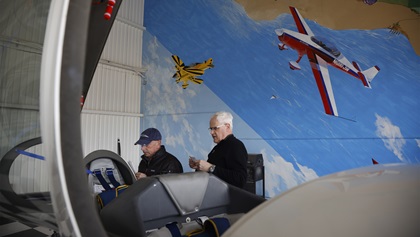
The 21-year-old Garmin GNC 250XL GPS/com showed my planned flight route along the edge of the Grand Canyon airspace, then on to Double Eagle II Airport in Albuquerque, New Mexico, about 400 nautical miles away. The trip generally paralleled Interstate 40 across northern Arizona and New Mexico.
I’d been tempted to fly a more direct and scenic route across Colorado, but higher elevations, remote and rugged terrain, and approaching snow conspired to keep me on the more highly traveled interstate path across the Rockies.
Besides, at 11,500 feet, I was picking up a 25-knot tailwind. No sense being greedy.
The combination of the ancient GPS and an iPhone on my knee, and unlimited visibility (Humphreys Peak near Flagstaff, Arizona, was plainly visible from 150 miles) made it easy to stay on course. But even in smooth air, the Extra requires constant attention.
The airplane’s symmetrical wing has no dihedral so, naturally, there’s no dihedral effect. That means that when the airplane starts to roll left, applying right rudder doesn’t pick it up. The airplane keeps rolling left while it yaws right. My comical attempts to eat a Snickers bar, or drink a Gatorade, had me wildly off course and altitude. There’s also no wing angle of incidence, so the airplane must hold a nose-high attitude in level flight, especially at high altitude.
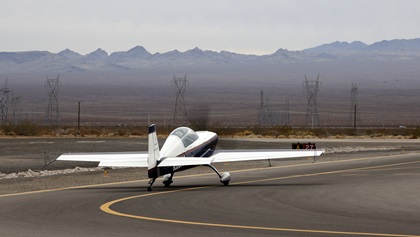
Refueling at Double Eagle confirmed the JPI engine monitor’s fuel flow readings were accurate. The Extra consumed an average of 13.2 gallons an hour during the 2.5-hour flight, and true airspeed at altitude was about 160 knots at 11,500 feet.
On the next leg, I crossed the Sandia Mountains near Santa Fe, rode through some bumps, and then lucked out with a 40-knot tailwind at 11,500 feet. The sun came out and, under the bubble canopy, I broke a sweat during the initial climb; was comfortable for the next half hour; got cold during the next hour, then thawed out before landing—a pattern that would repeat itself for the rest of the trip.
I dutifully selected the wing fuel tanks during the cruise portion of each flight, then celebrated with an aileron roll (or two) after switching to the fuselage, or “acro,” tank prior to descent. The acro tank has a standpipe that feeds fuel to the engine during zero- or negative-G maneuvers—something the wing tanks lack.
The Kansas prairie gleamed in golden twilight when I landed at Wichita Dwight D. Eisenhower National Airport and taxied to Yingling Aviation. I still had about 45 minutes of daylight remaining, and I was tempted to press on. But Yingling had a hangar, as well as a hotel within walking distance.
The forecast for the next day was continued perfection and an even stronger tailwind all the way to Maryland. Williams had been following N105MM’s progress on FlightAware and sent an encouraging text.
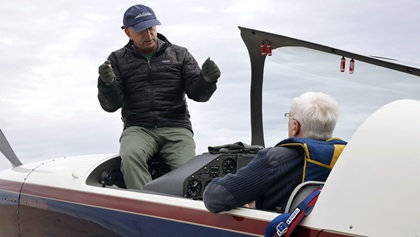
“I am glad you’re safely on the ground,” he wrote. “Easy day tomorrow, I hope.”
I got the tanks topped off, pushed the Extra into a hangar, added a quart of oil, and let the friendly folks at Yingling know I’d leave the next morning at first light. I texted my wife, Martha, on the way to the hotel to let her know the first day of the ferry trip had gone beautifully, my odds of getting home the next day (December 23) were excellent, and I expected to arrive about the same time as our two adult kids who were coming home for the Christmas holiday.
Martha knows the vagaries of long-distance travel in day-VFR airplanes, however, as well as the innate optimism of pilots making schedules.
“All’s good here,” she replied. “You’ll get here when you do.”
An exuberant end
Wichita was socked in with fog the next morning when I walked to Yingling. Visibility was one-quarter mile, and even the airliners were missing approaches and delaying departures.
Maddeningly, the skies were clear in all directions only six miles away.
I ate breakfast even though I wasn’t hungry, paced the lobby, and took a few snapshots of the foggy ramp. When the pilot shop opened, I bought a RAM mount for my iPhone since it was now my primary navigation. (The Garmin 250XL didn’t have a database covering the central or eastern United States.)
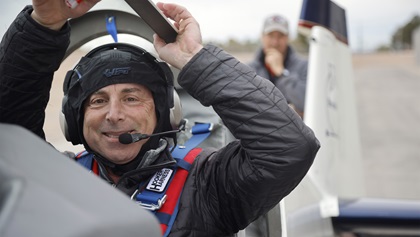
Finally, about 10:30 a.m. local time, the fog lifted enough for me to launch. I pointed the airplane east and climbed to 11,500 feet msl and rode a tailwind to Evansville Regional Airport in Indiana, refueled, and took off again.
Over northern Kentucky, the tailwind freshened to a whopping 50 knots. I had enough fuel to make it all the way home—but not enough daylight. If I continued, I’d land about 35 minutes after sunset, just beyond the end of civil twilight. The Extra has exterior navigation and strobe lights, but no lights whatsoever on the instrument panel.
I had a flashlight and headlamp in my flight bag. Yet as much as I wanted to get home, I decided to land 120 miles short in Morgantown, West Virginia. At the hotel, I turned on the Weather Channel and my heart sank when I learned that the next day’s forecast was dreary—and so were the following three days after that.
The wide-open weather window I’d enjoyed for most of the last 48 hours was about to slam shut. I second-guessed my decision to stop throughout a restless night. But weather conditions the next morning were better than forecast and the trickiest part was finding a ride to the airport at 6 a.m. on Christmas Eve.
When dawn broke at the airport, I was thrilled to see sunlight between the tops of the Appalachian Mountains and a broken layer of stratus clouds above them.
I crossed the last of the high terrain and descended in clear skies over western Maryland, and a tower controller at Frederick kindly granted my request for an overhead break. It was an exuberant end to a strenuous ferry flight, and it also marked a new beginning.
N105MM’s next trip will be to Southeast Aero in St. Augustine, Florida, for an avionics refresh, new vinyl graphics, and some TLC from the most knowledgeable Extra technicians in the country.
Thanks to Williams’ incredible generosity, AOPA has an exceptional new tool to accomplish our GA mission.
“Celebrating with an overhead break?” Williams texted after seeing the airplane’s telltale circular ground track on FlightAware. “Welcome home.”




